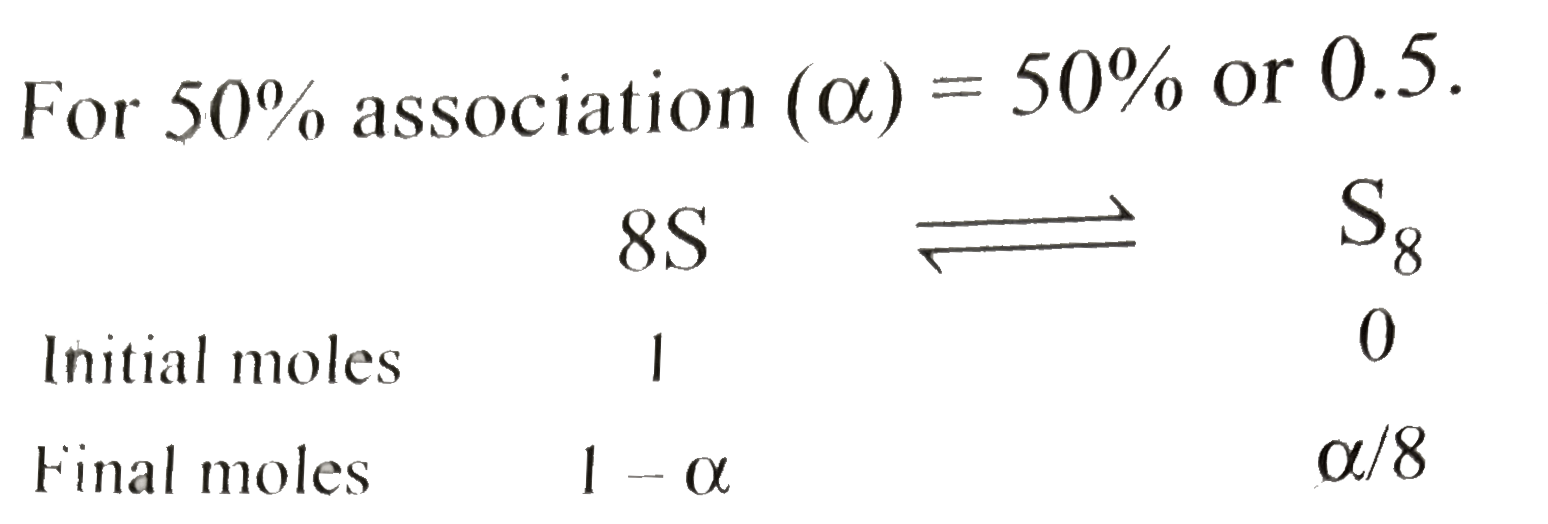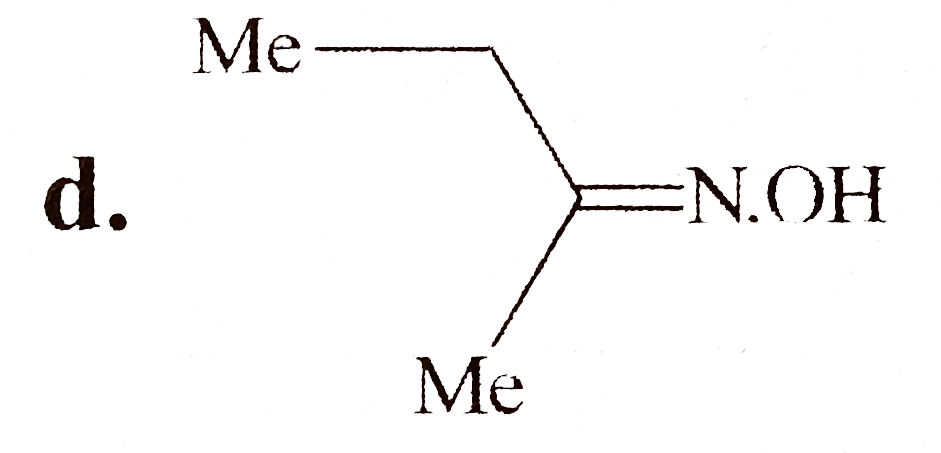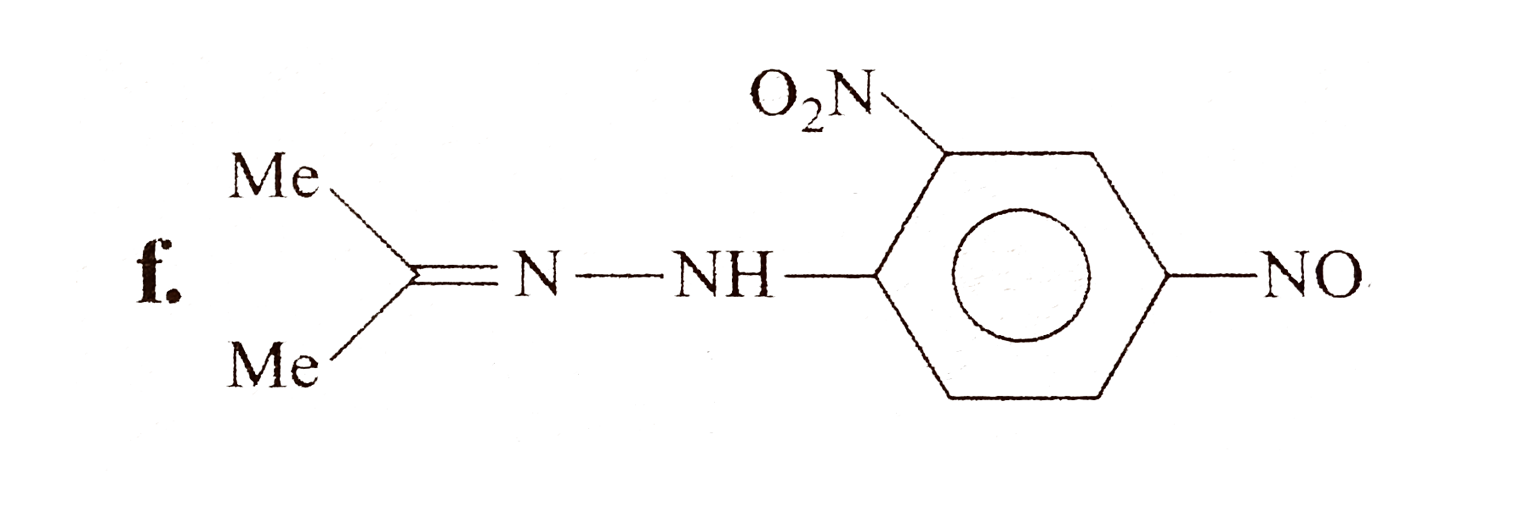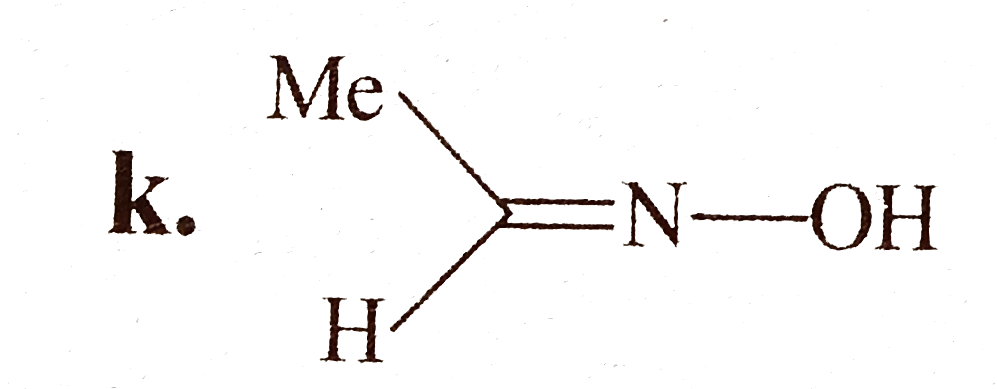Calculate the Van't Hoff factor (i) for the following if:
i.100% ionization or association takes place
b.50% ionization or association takes place
a.S ,b.Se , c.Te , d.P
e.As , f.Sb , g.B , h.AlCl3
i. Hg2Cl2 , j.HgCl2 , k.Be2C , l.Al4C3
m.CaC2 , n. Mg2C3
Text Solution
i. (a,b,c)
S,Se,and Te exist as S8,Se8 and Te8 molecules. So association takes place.
8S⇔S8⇔Se8,8Te⇔Te8
i=18
(d,e,f)
P,Asand Sb exist as P4,As4 and Sb4 molecules, so association takes place.
4P⇔P4,4As⇔As4,4Sb⇔Sb4
i=14
g. B exists as B12 molecule (icosahendron structure, 12 corners, and 20 faces), association takes place.
12B⇔B12
i=112
h. AlCl3 exists as dimer in non-polar solvent, so association takes place.
2AlCl3⇔Al2Cl6
i=12
i. Hg2Cl2 (calomel) ionizes to give Hg2+2 (mercurous ion)and 2Clө(So, i=3)Hg2Cl2⇔Hg+2+2Clɵ (So, i = 3)
j. HgCl2 (corrosive sublimate)is a covalent compound and does not ionize. (So i=1).
HgCl2 is poisonous and antidote is white of an egg.
(k,l) Be2C and Al4C3 in H2O gives CH4 gas, so it contains C4− methinide ion.
Be2C+4H2O⇔2Be(OH)2+CH4
Al4C3+12H2O⇔4Al(OH)3+CH4
Hence, Be2C and Al4C3 ionizes in solution as follows:
Br2C⇔2Be2++C4−(i=3)
Al4C3⇔4Al3++3C4−(i=7)
m.CaC2 given (CH≡CH) gas with H2O. So it contains
(Cɵ≡≡CɵorC2−2ion)
CaC2+2H2O⇔Ca(OH)2+CH≡CH
So CaC2 ionizes in solution as follows :
n. Mg2C3 gives (CH3−C≡≡CH) gas with H2O
so, it contains CH3C≡≡CɵorC4−3ions)
Mg2C3+4H2O⇔2Mg(OH)2+CH3−C≡≡CH
Mg2C3 ionizes in solution as follows :
Mg2C⇔2Mg2++C4−3(i=3)
ii.(a,b,c)

Total moles at equilibrium = 1−α+(α8)
i=Total molesInitial moles
=1−α+(α8)1
=8−8α+α8
=8−7α8=8−7×0.58=4.58=0.5625
Alternate method
i=(Number of ions×α)+(1−α)
=(18×0.5)+(1−0.5)=0.58+0.5
∴i=4.58=(0.5625)
(d,e,f)

i=1−α+α41
=(4−4α+α4)
=4−3α4=4−3×0.54=2.54=0.625
Alternate method i=(Number of ions×α)+(1−α)
=(14×0.5)+(1−0.5)
=0.54+0.5=2.54=0.625
g. 
i=1−α+α121
=(12−12α+α12)
=12−11α12=12−11×0.512=6.512=0.54
Alternate method i=(Number of ions×α)+(1−α)
=(112×0.5)+(1−0.5)
=0.512+0.5=6.512=0.54
h.
i=1−α+α21
=(1−2α+α1)
=12−11α12=12−11×0.52=1.52=0.75
Alternate method i=(Number of ions×α)+(1−α)
=(12×0.5)+(1−0.5)
=0.52+0.5=1.52=0.75

i=1−α+α+2α1
=(1−2α=1+2×0.5=2
Alternate method i=(Number of ions×α)+(1−α)
=(3×0.5)+(1−0.5)
=1.5+0.5=2
j. Since i=1, it does not ionize.
k.
i=1−α+α+2α1
=(1−2α=1+2×0.5=2
Alternate method i=(Number of ions×α)+(1−α)
=(3×0.5)+(1−0.5)
=1.5+0.5=2
j. Since i=1, it does not ionize.
l.
i=1−α+4α+3α1
=(1−6α=1+6×0.5=4
Alternate method i=(Number of ions×α)+(1−α)
=(7×0.5)+(1−0.5)
=3.5+0.5=4
m.
i=1−α+α+α1
=(1+α=1+0.5=1.5
Alternate method i=(Number of ions×α)+(1−α)
=(2×0.5)+(1−0.5)
=1.0+0.5=1.5
n.
i=1−α+2α+α1
=(1+2α=1+2×0.5=2)
Alternate method i=(Number of ions×α)+(1−α)
=(3×0.5)+(1−0.5)
=1.5+0.5=2
|
Topper's Solved these Questions
- SOLUTIONSBOOK - CENGAGE CHEMISTRYCHAPTER - SOLUTIONSEXERCISE - Solved Examples
40 Videos
- SOLUTIONSBOOK - CENGAGE CHEMISTRYCHAPTER - SOLUTIONSEXERCISE - Exercises (Linked Comprehension)
58 Videos
- SOLID STATEBOOK - CENGAGE CHEMISTRYCHAPTER - SOLID STATEEXERCISE - Ex 1.2 (Objective)
9 Videos
- SURFACE CHEMISTRYBOOK - CENGAGE CHEMISTRYCHAPTER - SURFACE CHEMISTRYEXERCISE - Archives Subjective
2 Videos
Similar Questions
Knowledge Check
Which of the following is a formula of methanides:
(a) Be2C
(b) CaC2
(c) Mg2C3
(d) Al4C3Aonly a,dBonly a,bConly c,dDonly b,dIF a=50% for Al2(SO4)3 then van't hoff factor would be
A1.5B0.5C3D2Which of the following electrolytes has the same value of van't Hoff factor (i)is that of Al2(SO4)3(if all are 100%ionised?
AAl(NO3)3BK4[Fe(CN)6]CK2SO4DK3[Fe(CN)6]
Which of the following is a formula of methanides:
(a) Be2C
(b) CaC2
(c) Mg2C3
(d) Al4C3
View SolutionWhich of the following show G.I.?
a.
b.
c.
d.
e.
f.
g.
h.
i.
j.
k.
l.
View SolutionWhich of the following electrolytes has the same value of van't Hoff factor as that of Al2(SO4)3(if all are 100%ionised?
View SolutionClassify the following into electrophilies and nucleophiles:
(a) H+ , (b) NH3
(c) AlCl3 , (d) NO+2
(e) CN− , (f) H2O
(g) ROH , (h) H2O
(i) Carbocation.
View SolutionWhich of the following electrolytes has the same value of van't Hoff factor (i)is that of Al2(SO4)3(if all are 100%ionised?
View Solution
